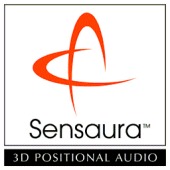|
Maxi Sound Fortissimo
by Tim "Flyboy" Henderson |
||||
|
Back in the spring COMBATSIM.COM™ posted a summary of the API wars, the battle between industry giants Creative Labs with their EAX standard, and Aureal with their A3d standard. Positional and hardware accelerated audio was evolving as rapidly as 3d graphics hardware. More recently a new contender has arrived in the form of Sensaura Audio. Sensaura is making a splash with their claims, if not their technology, and one of the first products to demonstrate their abilities is the Guillemot Fortissimo. Guillemot has a reputation for leading the edge in value/features, and their Maxi Gamer Xentor 32 is the hottest TNT2 product out there. With the addition of both Thrustmaster and Hercules to their collection, and now the launch of this 4 channel and digital PCI sound board, Guillemot takes an increasingly aggressive stand in the PC hardware market. Enter the Chip Sporting a new chip from Yamaha, and with support for the XG and GS Midi sounds in hardware, the Fortissimo is a product to be reckoned with. Dang! Not only 4 channel support, but support for EAX and A3d, and both DirectSound3d and DirectMusic IN HARDWARE. But can you believe... $49.99 on the net? Take a look at these specs...
Audio compatibility
The bundle is basic, including the board itself, installation CD, a second CD with Acid DJ, and an install guide. The full manual is online. |
 Sensaura Sound So what's all the fuss? Sensaura specializes in intellectual property pertaining to 3D positioning and signal processing algorithms. At the core of its 3D positioning algorithm is "Digital Ear Technology." Other significant innovations include their "MacroFX" and "MultiDrive." Sensaura comments that, "Our Digital Ear technology allows us to develop our HRTF filter library, producing more accurate filters than are possible with the normal commercial dummy head rubber ears. In fact these filters are nearly perfect left-right matching. "A second advantage we have is our patented transaural crosstalk cancellation (TCC) algorithm. For loudspeaker reproduction, this gives us better bass response than that obtainable from the algorithm used by everyone else following HRTF processing. We are addressing the very real consumer demand for 3D positioning over two speakers and headphones. "We're continuing to develop the algorithms to improve the two speaker and, specifically, headphone listening experience. We're addressing four speaker solutions via our new Sensaura MultiDrive(tm) system." OK. I'll bite. I like it when these guys talk sexy. But what's it all mean? Digital Ear Technology First of all, HRTF is an acronym that appears in literature from both Creative Labs and Aureal. HRTF stands for "head related transfer functions." Sensaura's positional 3D algorithms rely upon a library of HRTFs, and Sensaura measures HRTFs using its own proprietary artificial head system. Digital Ear Technology refers to the use of CAD/CAM to manufacture the ear assembly. The main purpose of digitizing ear assembly is to provide a spatially accurate pinna (outer ear) with perfect left-right matching. In the absence of primary auditory cues, the outer ear plays a central role in localising sound. Yes, you do need a degree in science to figure this stuff out. But fools go where angels fear to tread, so listen on. The complex and convoluted shapes of the ear resonate at different frequencies in a direction dependent manner, and modify the spectrum of the sound waves before they reach the tympanic membrane. You know, that one that you ain't suppposed to puncture when you stick your pencil in it? Go to Page Two.
|
|||
|
Copyright © 1997 - 2000 COMBATSIM.COM, INC. All Rights Reserved. Last Updated November 10th, 1999 |
||||
